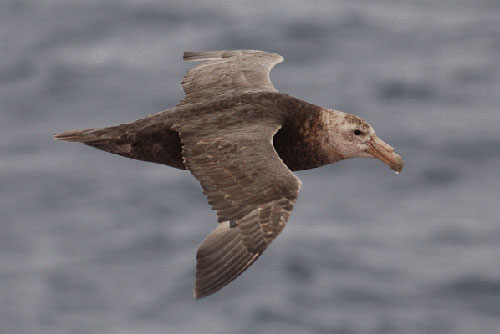Laurie Thiers (Centre d’Études Biologiques de Chizé, Centre National de la Recherche Scientifique, Villiers en Bois, France) and colleagues write in the journal Marine Ecology Progress Series on the at-sea distribution and behaviour of Northern Macronectes halli and Southern Giant Petrels M. giganteus from the French Crozet and Kerguelen Islands.
The paper’s abstract follows:
“We studied the year-round distribution and at-sea activity patterns of the sibling species, northern giant petrel Macronectes halli and southern giant petrel M. giganteus. Loggers combining light-based geolocators and immersion sensors were used to provide year-long data on large-scale distribution and activity of both species from the Crozet Islands (46°25’S, 51°51’E) and northern giant petrels from the Kerguelen Islands (49°19’S, 69°15’E) in the southern Indian Ocean. Argos platform transmitter terminals (PTTs) were used to track fine-scale movements of breeding adults and juveniles. Overall, adults remained within the Indian Ocean during and outside the breeding season, whereas juveniles dispersed throughout the Southern Ocean. In accordance with previous studies, differences in adult distribution and behaviour were greater between sexes than species: females dispersed more widely than males and also spent more time sitting on the water, particularly during the winter. Observed differences in distribution have important conservation implications: adults, especially males, overlap to a large extent with longline fisheries for Patagonian toothfish Dissostichus eleginoides in shelf areas within national Exclusive Economic Zones (EEZs), whereas adult females and juveniles are more likely to encounter high-sea longline fleets targeting tuna in subtropical waters. The circumpolar wide ranging behavior of naïve juvenile birds makes them particularly susceptible to interaction with a wide range of longline fisheries.”

Southern Giant Petrel at sea, photograph by Warwick Barnes
With thanks to Deborah Pardo, ACAP European News Correspondent for information.
Reference:
Thiers, L., Delord, K., Barbraud, C., Phillips, R.A., Pinaud, D. & Weimerskirch, H. 2014. Foraging zones of the two sibling species of giant petrels in the Indian Ocean throughout the annual cycle: implication for their conservation. Marine Ecology Progress Series 499:233-248.
John Cooper, ACAP Information Officer, 29 March 2014

 English
English  Français
Français  Español
Español